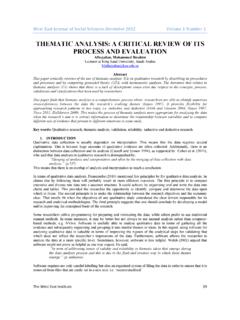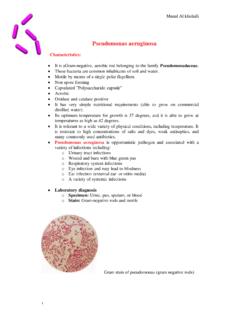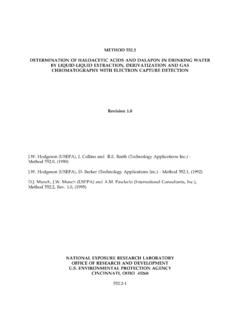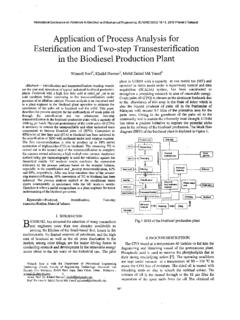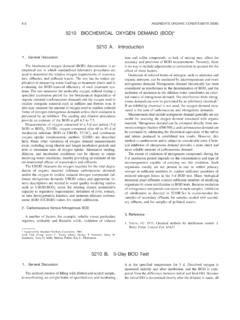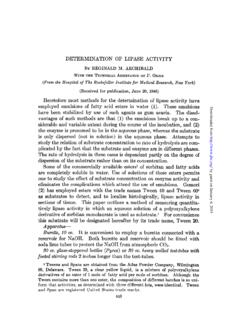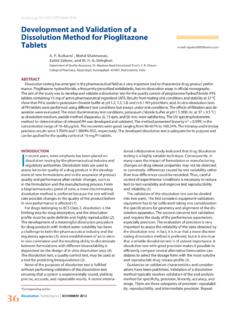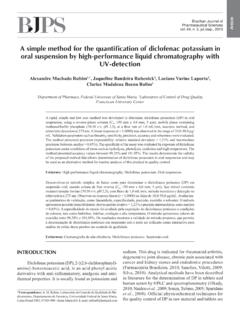Transcription of Food analysis - KSU Faculty
1 food analysis 445 BCH 30 Marks 5 quizes 5 reports 15 final Final exam 20/4/2014 20/6/1435 food acidity objective To determine total acidity of milk, juice, vinegar and oil acid value food acidity food acids are usually organic acids, with citric, malic, lactic, tartaric, and acetic acids being the most common. However, inorganic acids such as phosphoric and carbonic (arising from carbon dioxide in solution) acids often play an important and even predominant role in food acidulation. Citric acid malic food acidity The organic acids present in foods influence the : ( ,tartness), 2. color (though their impact on anthocyanin and other pH-influenced pigments), stability (via inherent pH-sensitive characteristics of organisms), keeping quality (arising from varying chemical sensitivities of food components to pH).
2 Organic acids may present : Naturally, By Fermentation Added as part of a specific food formulation The importance of determining food acidity 1- determine the degree of maturity of fruits and vegetables If the determination of organic acids contained in the grape is malic acid , the description is not yet ripe grapes, ripe grapes contains a lot of tartaric acid . The titratable acidity of fruits is used, along with sugar content, as an indicator of maturity, generally the higher the maturity, the lower the acid content. in the ripening process, such as tomatoes from green to mature stage , there is an increase in sugar content. The importance of determining food acidity determine the freshness of foods for example in milk, the more the lactic acid levels, means that milk is rotten. 3. Acidity indicators reflect the quality of food the amount of organic acids in food directly affects the food flavor, color, stability, and the level of quality.
3 4- determination of acid on the microbial fermentation process Such as: fermentation products in soy sauce, vinegar and other acids is an important indicator of quality. food acidity determination There are two ways to express food acidity: Titratable acidity Simple estimate of the total acid content of food Better predictor of acid impact on flavor Hydrogen concentration pH Depend on the strength of acid condition Titratable acidity Titratable acidity is determined by neutralizing the acid present in a known quantity (weight or volume) of food sample using a standard base. The endpoint for titration is usually either a target pH or the color change of a pH-sensitive dye, typically phenolphthalein. 1- determination of Milk Acidity (Titratable Acidity): The acidity of fresh milk is due to: phosphates, casein and whey proteins, citrates and carbon dioxide dissolved during the process of milking.
4 Developed acidity which is due to: lactic acid produced by the action of bacteria on lactose in milk. Generally the acidity of milk means the total acidity (Natural + developed) or titrable acidity. The acidity of cow milk ranges from to %. Acidity is expressed as percentage of lactic acid . Method: 1. Mix the milk sample thoroughly by avoiding incorporation of air. 2. Transfer 10 gm milk to conical flask or beaker . 3. Add equal quantity of distilled water . 4. Add 3-4 drops of phenolphthalein indicator and stir 5. Rapidly titrate the contents with N NaOH solution, continue to add alkali drop by the drop and stirring the content till first definite change to pink colour . 6. Note down the final burette reading. Result and Calculation: -Lactic acid %= (No of ml. of N NaOH Required for neutralization x ) x 100 Weight of the sample gram of lactic acid is found in 1 ml of N lactate 2- determination of total acidity in juice : The acidity of natural fruit juices is the result mainly of their content of organic acids.
5 For example, most fruits contain the tricarboxylic acid (citric acid ) whereas grapes are rich in tartaric acid & peaches, apricots & plums in malic acids. Both tartaric & malic acids are dicaroxylic acids. The acidity of fruit juice may be determined by simple direct titration with sodium hydroxide, using phenolphthalein as an indicator. Method: 1- Weight 10 gm juice in beaker. 2- Add 25 ml of distilled water. 3- Titrate with NaOH , using 2 drops of phenolphthalein as an indicator. Calculations: -Calculate percent acidity of fruit juice ( citric acid ): -Wt. of citric acid = ( NaOH X vol. of NaOH (in liter)X -%of total acidity = (wt. of acid / wt. of sample) X 100 -Normal range for citric acid = - % 3- determination of total acidity in vinegars: The total acidity of vinegars is derived both from the original fermentation process & from acidic salts present in the original used for fermentation.)
6 It may be determined titrimetrically using phenolphthalein as an indicator . The natural acidity of vinegar is mainly due to the presence of acetic acid (CH3 COOH) , which is volatile . Method: determination of total acidity 1- Weight 5 gm vinegar. 2- Add 50 ml of distilled water. 3- Titrate with NaOH , using 2 drops of phenolphthalein as an indicator. Calculations: -Calculate percent acidity as acetic acid (MW= ) - Wt. of acetic acid = ( NaOH X volume of NaOH in liter X MW) - % of total acidity= (wt. of acid / wt. of sample) X 100 4- acid value : -The acid value is defined as the number of milligrams of potassium hydroxide required to neutralize the free fatty acids present in one gram of fat. -It is a relative measure of rancidity as free fatty acids are normally formed during decomposition of oil glycerides.
7 -The value is also expressed as percent of free fatty acids calculated as oleic acid . Principle: The value is a measure of the amount of fatty acids which have been liberated by hydrolysis from the glycerides due to the action of moisture, temperature and/or lipolytic enzyme lipase. The acid value is determined by directly titrating the oil/fat in an alcoholic medium against standard potassium hydroxide/sodium hydroxide solution. Method: 1. Mix the oil or melted fat thoroughly before weighting. 2. Weight accurately about 5 g of cooled oil sample in a 250 ml conical flask. 3. Add 50 ml of freshly neutralized hot ethanol. 4. Add one ml of phenolphthalein indicator solution. 5. Boil the mixture( in water bath) for about 5 minutes and titrate while hot against standard alkali solution shaking vigorously during the titration.
8 Calculation: acid value = X ( V x N) / weight of sample Where V = Volume in ml of standard potassium hydroxide or sodium hydroxide used N = Normality of the potassium hydroxide solution or Sodium hydroxide solution. W = Weight in g of the sample Discuses the result you got for each sample and compare it to the normal range



